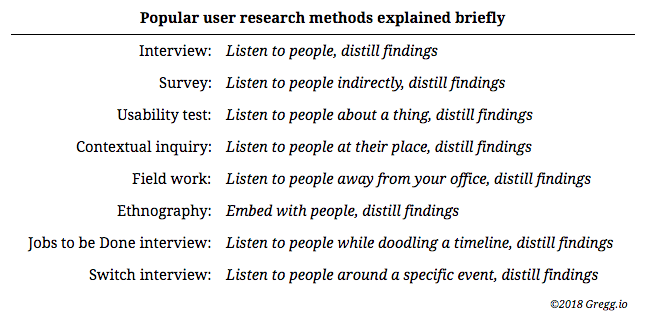This made the rounds on Twitter recently after I shared it, so I thought I’d give it a proper home:

And here it is in text form:
Popular user research methods explained briefly
Interview: Listen to people, distill findings
Survey: Listen to people indirectly, distill findings
Usability test: Listen to people about a thing, distill findings
Contextual inquiry: Listen to people at their place, distill findings
Field work: Listen to people away from your office, distill findings
Ethnography: Embed with people, distill findings
Jobs to be Done interview: Listen to people while doodling a timeline, distill findings
Switch interview: Listen to people around a specific event, distill findings
Andrea Hill and my former Mailchimp colleague Steph Troeth questioned my division of Switch interviews from Jobs to be Done [JTBD] interviews. That the switch interview is so tied to a very recent event differentiates it for me, but I might be splitting hairs. JTBD could be about a product or service you’ve used for years, and that—to me—makes it less about the switching moment and more about the role of the product in your life.
A handful of other folks responded that I left out the things that come before the methods, the rigor that comes around distillation, and the actionable insights that follow distillation.
This is accurate feedback—research requires:
- An understanding of the problem space
- Alignment with larger business goals
- Knowledge of the unanswered questions
- Convergence on the appropriate research toolkit to answer those questions
- Identification of the right people to listen to
Then we get to the listening to people part that my tweet captured.
Then we move along to:
- Synthesize what we heard
- Develop answers to the business and product questions
- Share our findings with different stakeholders in different ways
- Identify the remaining questions and next steps
However, this is a lot to fit in a tweet. And it’s still woefully thin.
The field of user research is maturing. As it does, it’s natural that our practices and methods mature too. However, with maturation comes dogma and codification—a clear delineation of the acceptable ways of doing something and how to talk about it. This creates a barrier to entry for new practitioners.
Fundamentally, our field really is about listening to people to make better decisions.
